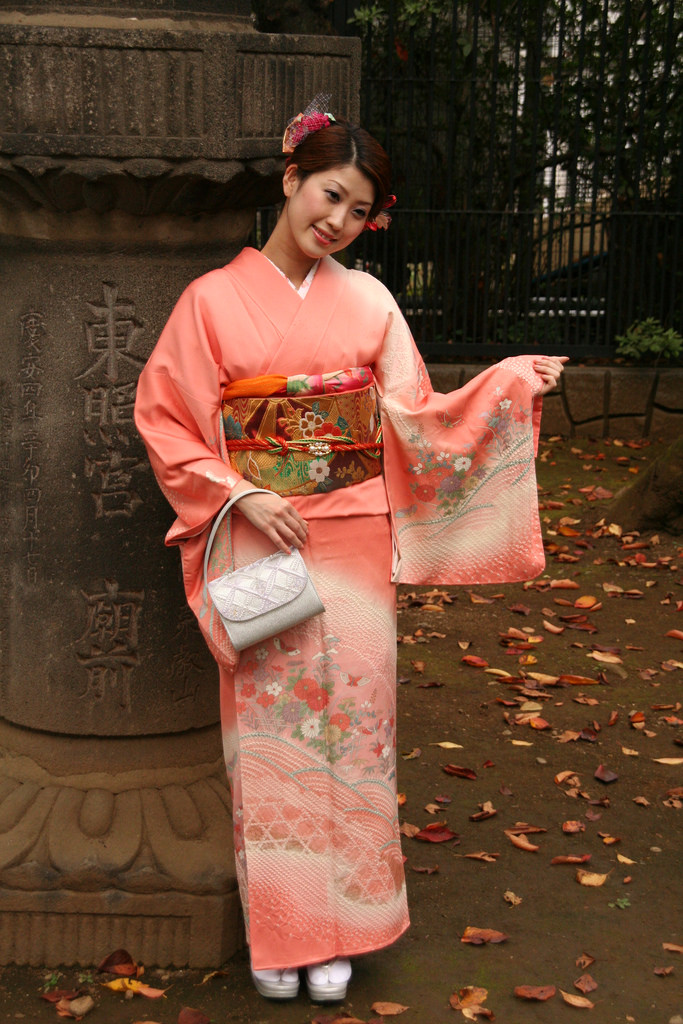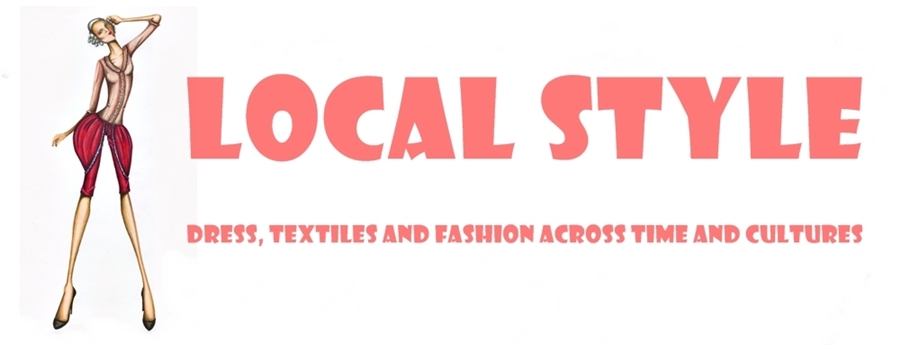 photo courtesy Stefan Schlautmann
photo courtesy Stefan Schlautmann One of the things that I would definitely like to try on one day is a kimono. Such a simple in its construction garment yet so beautiful and elegant it looks on a woman. And the prints and motifs that decorate some special occasion pieces? They are simply fascinating, real works of art decorated with brush painting, embroidery, tie-dyeing, applique and even with gold and silver.
 Furisode kimono, early 20th century. Silk; metal thread embroidery; couched; painted. This type of kimono is worn by an unmarried woman, and is characterized by vivid colours, bold patterns and curved mid-length sleeves. The Textile Museum of Canada
Furisode kimono, early 20th century. Silk; metal thread embroidery; couched; painted. This type of kimono is worn by an unmarried woman, and is characterized by vivid colours, bold patterns and curved mid-length sleeves. The Textile Museum of Canada
That's how a Hoian court lady wearing junihitoe looked like. Photo source
In the twelfth century when samurai came to power the ladies discarded the uncomfortable and bulky junihitoe and adopted the simple kosode and hakama which used to be the undergarments at the earlier times. It is from kosode that the present form of the kimono developed. This practical garment fit everyone. It was made from a piece of fabric 9 yards (8.2m) long and 15 inches (38cm) wide. The fabric was cut into rectangular pieces and stitched into the basic kimono form. Later an elaborately decorated outer robe, uchikake, was added and with time when more ornate textiles were developed the kosode itself started to be more decorative and became what we know now as kimono.
 photo courtesy Stefan Schlautmann
photo courtesy Stefan Schlautmann  Unlined Kimono with Landscape and Poem second half of the 18th century Silk gauze; silk embroidery and resist dyeing. The Metropolitan Museum of Art
Unlined Kimono with Landscape and Poem second half of the 18th century Silk gauze; silk embroidery and resist dyeing. The Metropolitan Museum of ArtThe same basic pattern with only minor alterations is used for men's, women's and children's kimonos. It can be made with a variety of fabrics and can be worn as casual everyday wear or as formal wear and for festive and ceremonial events. The kimono is wrapped left over right and held closed with an obi, or sash. In the case of women, the obi is tightly wrapped several times around the midriff and tied in the back. Men use a narrow obi to hold the kimono closed. This is wrapped twice slightly below the waist and tied in a simple knot in the back.
 photo courtesy Stefan Schlautmann
photo courtesy Stefan Schlautmann The size and style of the motif of the kimono, as well as the quality and colour of the fabric indicate the age, status and taste of its owner. Bright colours, large motifs and long sleeves are worn by young girls. Subdued colours, smaller decorations and short sleeves are considered appropriate for married women.
The designs that adorn the surface of a kimono range from simple stripes or solid colours to elaborate pictorial images that often have special meaning and auspicious significance which derives from religious or popular beliefs. The crane for example, is believed to live for a thousand years and to inhabit the land of the immortals, so it is used on kimono as a symbol of longevity and good fortune. Or bamboo, that bends in the wind but never breaks, is used as symbol of perseverance.
Kimono, 1870-1890 Satin; embroidery; applique The three figures, shishi and peonies are composed of satin and crepe silk, dyed in bright colours, which have been applied to the black ground and then outlined with couched gold-wrapped thread. The bridge, clouds, water, leaves and other elements are also in couched gold embroidery. The design is padded in places to add extra three-dimensionality, while the eyes of the shishi are of glass as are those of the main figure on the bridge who also has actual hair, probably from a yak or other animal, and buttons of metal. It is possible, therefore, that this garment belonged instead to a high-ranking courtesan. The Victoria and Albert Museum
While some motifs are purely decorative others are believed to be protective, have religious meaning or be simply narrative. Birds, animals, butterflies and dragonflies often appear on kimono, along with other motifs drawn from nature such as water, snow and clouds. On some kimono whole landscapes of mountains and streams are depicted. The numerous different ways in which such popular natural motifs are used on garments is testament to the skill of kimono designers, dyers and embroiderers.
In the early 21st century the kimono is still very much alive and circulates as national dress of Japan, as fashionable formal wear, as nostalgic vintage costume, as signifier of Japan's craft traditions and as object of art.
References
Textile Art of Japan by Sunny Yang and Rochelle M.Narasin
Encyclopedia of World Dress and Fashion, vol.6 East Asia
If you enjoyed this post please like my page on Facebook Thank you!





Wow!!! Such beautiful kimonos!!! They are so beautifully decorated and embroidered!!! Real art works!!! I would love to try one too!!!:) :) :) it was really interested to read about the history of kimono! Great post! :)
ReplyDeleteThank you for the interesting history about these elaborate, embellished Kimonos Olga. You would look beautiful in one I'm sure! I have two "Kimono-style" pieces: a cardigan and a dress. But they are not anything like these ones you have shown.
ReplyDelete❤️carmen
https://fashionableover50.wordpress.com
I am very surprised you have never worn a kimono before. You are so exotic and worldly I would have guessed yes for sure. Ritual in clothing is such an interesting topic. I wonder if I could have a kimono custom made what i would put on it to reflect my status and inner being. I am thinking and Iron Man kimono would be good :) Also, maybe I could make a line of kitty kimonos for cats. They would look cute in them. Wonderful article and great shots! Happy day to you my friend!
ReplyDeleteThey really are works of art, no wonder so many people I know display them rather than wear them.
ReplyDeleteThese truly are works of art. The detailing, the colours, such intricate work. I'd love to see you in a kimono, Olga. You would look amazing in one.
ReplyDeletehttp://petitesilvervixen.blogspot.co.uk/
you would look stunning in a kimono, I'm sure. I'll hope you'll get the chance to wear one...and I must admit I would love to try on a kimono too, at least once in my life.
ReplyDeleteExcellent.
ReplyDeleteNice outfits. Your blog is Very enjoyable. You have very good information about Japanese fashion.if you want to know something about men's fashion, Kidoriman Review is one of the famous Japanese style outfits provider. Must visit us!!
ReplyDelete